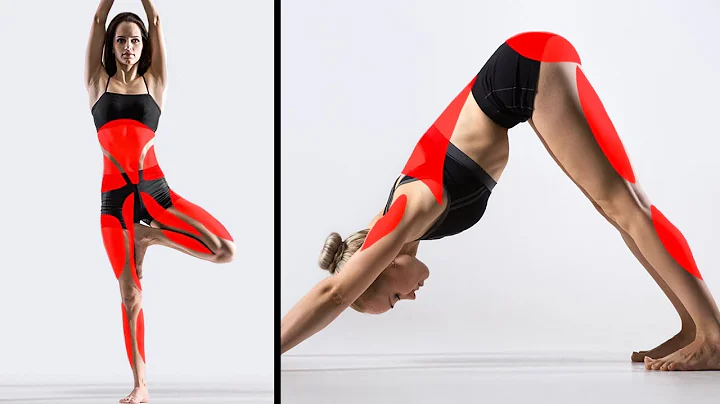The basic yoga postures may seem simple, but they will also challenge the practitioner's body and mind.
On the Internet, we can see a lot of yoga photos, which often make many people think that yoga practice is a flowing and energetic way of exercise, but the fact is that the real challenge of yoga does not come from moving from one posture to the other. The transition of another posture, on the contrary, the core of yoga is to cultivate the practitioner's awareness and concentration, and this is especially prominent in the process of practicing basic postures.
Take these five postures as examples: Mountain Pose , Cane Pose, Standing Forward Bend, Simple Sitting and Supine Pose.
If you have also practiced yoga and are familiar with these five postures, I believe you will not think that they are difficult to do. But in fact, these postures have their own intrinsic value. Each of them supports our sense of strength and stability, and this 'sense of support' requires us to calm down to experience and perceive it. I think many yoga practicing friends will have the same feeling as me, that is, in static postures, our brains will become conscious, various thoughts will begin to emerge in our minds, and we will truly enter the present state completely. It's very challenging.
They look simple, but they are not.
In today's article, I will share with you some techniques that can help us practice the five basic yoga postures mentioned above with concentration.
Mountain Pose Tadasana

Points of Interest
Mountain Pose is a very grounding pose. Focus on the feeling of the bottom of your feet going down as we lift your spine and top of your head. If we feel some discomfort while standing in Tadasana, then this feeling reminds us that our posture is not in the correct position. Therefore, adjustments need to be made to relieve physical tension. The first thing we need to make sure is that our core muscles are engaged and our shoulders are relaxed. Bend your knees slightly at the same time, and don't worry about whether your feet are close to each other. This small detail will vary from person to person. If the instructions given by the teacher are too precise, it will lead to too much control in the posture. The best situation is that the practitioners can relax while achieving the essentials in the posture.
Enter the pose
with your feet parallel and slightly apart, or the big toes are touching and the heels are slightly apart.
Lift your heels slightly, spread out your ten toes to compact the ground, and then gently place your heels back on the mat. Gently rock the body back and forth, side to side, and gradually reduce the amplitude of the shaking until it stops. At this time, the weight of the body is evenly distributed on the feet, and we can feel the energy going up from the feet and through the core.
The sternum should be lifted upward, but the ribs should not protrude outward. Spread your collarbone to the side, pulling your shoulder blades downward and away from your ears. Keep your arms relaxed beside your torso, palms facing your body or forward.
Keep the head of your head facing the center of your pelvis, maintain balance, the bottom of your chin is parallel to the ground, your throat is soft, your tongue is wide and flat at the bottom of your mouth, your eyes are gentle, and your breathing is smooth.
Standing Forward Bend Uttanasana

Focus
Forward Bend Asana is a posture that is connected to the earth. The practice of Standing Forward Bend can help the body enhance the strength and stability of the legs. This pose injects energy into the body of the practitioner. In standing forward bend, our knees can be straightened or slightly bent. What needs to be remembered is that everyone's hamstrings flexibility is different, so when practicing this action, you should not be concerned about the state of the knees. There are hard-core requirements, which is especially important among people who are beginning to practice.
In this action, when the body leans forward, press down on both feet and cooperate with the thighs. Don't let the legs become weak. Our back also needs to participate, prolong the exhalation time, let the trunk face the legs, and avoid arching the back. While releasing the pressure on the spine, it can also have a calming effect on the nervous system of the body.
Enter the pose
Start from Mountain Pose, standing in front of the yoga mat, with your hands hanging naturally on both sides of the body.
Bend your knees slightly and start folding your torso downward with your hips as the center.
The hands can choose to fall beside the feet or on the ground in front of the body.
Inhale, extend your spine, exhale, and gently straighten your legs, but do not overextend. Lift the kneecap upward, and gently draw the inner thigh closer to the torso.
When exhaling, extend the torso downward, but do not arch your back. Lengthen your neck, extending the top of your head toward the ground and drawing your shoulders toward your back and hips.
Cane Pose Dandasana

Points of Attention
Many yoga masters have mentioned that the practice of sitting postures will make us more focused and engaged. This cane pose is one of them. It requires the practitioner to focus all his attention on the core muscles and legs, adjusting the position of the back, neck and head of the body in this pose. Using a blanket to elevate your hips can help almost all practitioners better engage their core muscles. We can also consider using yoga bricks and place two yoga bricks under the hands to give the hands a place to rest. This keeps your back straight.
Entering the pose
Enter from a sitting position with your legs straight forward.
Put your hands on both sides of your hips, with your arms straight.
The big toes of both feet touch together, leaving a certain space between the heels.
Hook your feet back and point your toes toward your body.
Press your big toe forward, rotate your thigh inward and downward, and press down with your femur.
The sternum extends from the navel, and the collarbone spreads out.
Relax your ribs and pull your upper arms back.
When exiting the pose, release your arms and shake your legs.
Easy Sitting Sukhasana

Points of Interest
Like the Cane Pose, the comfort of this pose depends on the flexibility of the hamstrings. We can use yoga blocks, bolsters, or blankets to elevate our hips so that they are higher than our knees. The main goal of this pose is to find the right support to keep your pelvis neutral. Hip flexibility directly affects our sitting posture.
Entering the pose
Sit down on the mat, bend your knees, open your knees to both sides, cross your calves, let one foot slide under the other knee, and move the calves toward the torso.
Relax your feet so that the outer edge of your foot rests comfortably on the ground and the inner arch of your foot falls under the tibia of the opposite leg. There should be a comfortable gap between foot two and pelvis.
Keep the pelvis in a neutral position and do not tilt forward or backward.
The tailbone is elongated toward the ground, stabilizing the shoulder blades, against the back, and elongating the upper body. Don't arch your lower back or draw your ribs forward.
We can choose to either fold our hands on our thighs, one hand inside the other, palms facing up, or place our hands palms down on our knees.
We can maintain this sitting posture for a long time, but one thing we need to pay attention to is that after maintaining the sitting posture for a certain period of time, we should alternate the crossed legs, so that the left and right legs can be above the same time.
Corpse Pose Savanasa

Points of Attention
This pose is a posture used in resting techniques in yoga classes. It is the essence of yoga practice, giving time for our bodies and minds to deeply relax. Rather than activating muscles, Sarva Pose shifts the body from a state of stress into a relaxation response to heal and rejuvenate. We can use blankets, pillows or cushions to create this feeling of relaxation, and placing a pillow under the knees can relieve tension in the lower back and hips. Placing a folded blanket under the head helps the neck maintain its natural curve, allowing the practitioner to feel fully sunk into the ground. The pose needs to be focused more on how it makes us feel than on what the pose ‘should’ be.
Relax
Sit on the mat with your knees slightly bent, lean back and bend your elbows.
When inhaling, slowly extend your legs, spread your feet, and point your toes slightly inward.
Place blankets or pillows under your hips, knees and neck, keeping your shoulders down and away from your ears.
Lie down on your torso, with your arms stretched toward the ceiling and perpendicular to the floor. Rock slightly from side to side, feeling your ribs and shoulder blades away from your spine, then place your hands on the mat at a comfortable distance from your sides.
The body is completely relaxed and maintained for at least 5 minutes.
When exiting the pose, exhale, gently turn to one side, press the ground with your hands, stand upright, and then slowly raise your head.





















